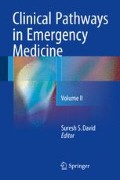Abstract
-
In severely injured patients, there is a distinct risk of missed or delayed diagnosis of injury.
-
Missed injury is most often due to incomplete history or examination or the non-performance of essential imaging and laboratory testing.
-
Systematic errors and multifactorial error avoidance techniques decrease the risk of missed injury.
-
Tertiary Survey is a one method shown to work in the acute trauma patient.
Access this chapter
Tax calculation will be finalised at checkout
Purchases are for personal use only
References
Hardcastle TC. Missed injury – decreasing morbidity and mortality. A literature review. S Afr J Surg. 2011;47(4):199–201.
Keijzers G, Giannakopoulos GF, Del Mar C, Bakker FC, Geeraedts LMG. The effect of tertiary surveys on missed injuries in trauma: a systematic review. Scand J Trauma Resusc Emerg Med. 2012;20:77.
Pfeifer R, Pape HC. Missed injuries in trauma patients: a literature review. Patient Saf Surg. 2008;2:20.
Clark DL, Gouveia J, Thomson SR, Muckart DJJ. Applying modern error theory to the problem of missed injuries in trauma. World J Surg. 2008;32:1176–82.
Reason J. Human error: models and management. BMJ. 2000;320:768–370.
Clarke DL, Furlong H, Laing GL, Aldous C, Thomson SR. Using a structured morbidity and mortality meeting to understand the contribution of human error to adverse surgical events in a South African regional hospital. S Afr J Surg. 2013;51(4):122–6.
Smith WA, Hardcastle TC. A crushing experience: the spectrum and outcome of soft-tissue injury and myonephropathic syndrome at an Urban South African University hospital. Afr J Emerg Med. 2011;1:17–24.
Skinner DL, Laing GL, Ryan L, Rodseth RN, Hardcastle TC, Muckart DJJ. Blunt cardiac injury in critically ill trauma patients – a single centre experience. Injury, 2015;46(1):66–70.
Croskerry P. Critical thinking and decision making: avoiding the perils of thin slicing. Ann Emerg Med. 2006;48:720–2.
Enderson BL, Reath DB, Meadors J, et al. The tertiary trauma survey: a prospective study of missed injury. J Trauma. 1990;30:666–9.
Author information
Authors and Affiliations
Corresponding author
Editor information
Editors and Affiliations
Rights and permissions
Copyright information
© 2016 Springer India
About this chapter
Cite this chapter
Hardcastle, T.C. (2016). Tertiary Survey and Avoiding Missed Injury. In: David, S. (eds) Clinical Pathways in Emergency Medicine. Springer, New Delhi. https://doi.org/10.1007/978-81-322-2713-7_40
Download citation
DOI: https://doi.org/10.1007/978-81-322-2713-7_40
Published:
Publisher Name: Springer, New Delhi
Print ISBN: 978-81-322-2711-3
Online ISBN: 978-81-322-2713-7
eBook Packages: MedicineMedicine (R0)

